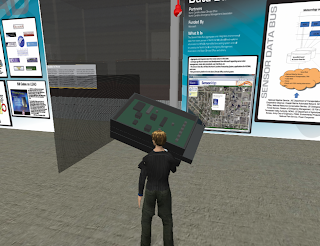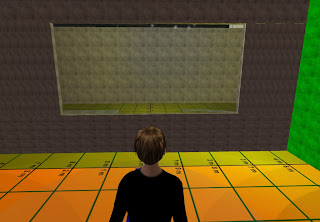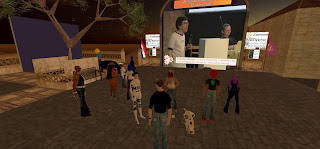It's odd sometimes, the way backlashes go. I've been blogging a bit, and being somewhat evangelistic about the 3D web. I didn't invent the term, and wasn't among the first to catch on, but I have a gut feeling (me and Chertoff) that the term means something. Lately, especially after the
LA Times article about the death of commerce on the 3D web, I've been approached by multiple people who want to explain to me that this is all a tempest in a teapot.
A proper, direct response to the LA Times article about Second Life can be found
here, and
here, so I won't try to recapitulate the common myths that make up such negative press. I was considering reasons why I am intrigued by the whole topic of virtual worlds, though, and I wanted to jot some of these down. These observations are shaped by my own interests, by past projects I worked, and so forth. You may discover other reasons to pay attention to the 3D web.
Real and Virtual are MergingThis is a drum I was beating well before I delved into Second Life.
In this older post, and
this one soon after, I talked about Mobile2.0 and Web2.0, trying to relate these terms to this larger idea of real and virtual merging. The main idea was that mobility and the new web were, in part, about the 'web of things'. Sensors and actuators talking on the web, and smarter applications to discover and manipulate this explosion of new information and services. Whole new types of applications stretching the definition of the web. Virtual worlds are important because they are a metaphor for this merging. In a way, our avatars allow us to cross the barrier, and physically inhabit the web of things. That's a bit sketchy, but I see the 3D web riding the coat-tails of the emerging web of things.
There are potential, practical benefits to visiting the virtual world to understand and manipulate the physical too. I've been interested lately in the development of EOLUS One,
as described in this UgoTrade blog entry. This is a fairly wide-ranging project, but it does serve as an interesting illustration real world/virtual world merging.
People Make a ComebackThe ubiquitous social networking web site provides many benefits. I'll pick on a few, and tie them to a virtual world experience:
- a venue to expand social/professional networks
- a tool to maintain connections to existing friends
- a platform to shape and present our own identity
- a tool to filter and flag important information (use of social networks to compensate for a deficit of attention)
- a collective tool to add value, from which we individually extract benefit
All of these points can be extracted from classic definitions of Web2.0, and many of the points are mirrored in virtual worlds such as Second Life.
Expanding Social NetworksThe first point, virtual worlds as a venue for expanding social networks, is primarily a function of the ability of a virtual world to create an event, or common experience. Think about where friendships start, it is often based on some shared experience, like a college course, or a conference, or some notable event. Virtual worlds can provide an immersive, compelling experience from which these connections can take root.
Social networking also relies on sharing connections, in a friend-of-a-friend style. Given the existence of shared experience in virtual worlds, the familiar mechanism of meeting new people through current friends has a virtual analogue.
Maintaining Current ConnectionsIt's probably a question for sociologists, but what quality of social experiences can be achieved in a virtual environment? I'm quite sure it's not the same as real life, but I also suspect it's a richer interaction than what one would suspect.
We're using tools like Twitter, Flickr, and FaceBook as a way to keep up with our friends and colleagues when we're separated by time or distance. The function of these tools do not map onto the real-time nature of virtual worlds, but I suspect that virtual worlds can add some unique new tools to serve these ends. One example that comes to mind is the ability to establish 'hang outs' particular to a group of friends and colleagues.
Shaping IdentityPeople use social applications as a way to shape and present themselves. Virtual worlds such as Second Life have an economy partially based on the customization of personal avatars. People take great care to build an image of themselves. Does this aspect of virtual worlds play into this basic function of social networking applications? I guess this is another one for the sociologists...
Tapping into Collective PowerSuccessful Web2.0 sites often become so because they provide tools to build something interesting, let the tools loose on the world, and leverage the resulting content. I'd toss out Wikipedia and Flickr as two prime examples. There's a fundamental principle at work there, and a lesson that virtual world developers need to take to heart.
Professional 3D developers really don't like Second Life. I picked that up! I can see why, I think the building tools are crummy. This is something I had observed in a previous blog entry, but it bears repeating...the quality of the tools matters, but more important than professional level, sophisticated building tools are accessible tools, available in-world, suitable for the average Joe to get something done. There are indeed master builders within environments like Second Life that could take advantage of special tools, but I will guess that the vast majority rely on simple constructs, and use the ecosystem to purchase the rest.
I think about how bad HTML is, and how crude the tools still are, and would not be suprised to find out that, back in the day, that the web was dismissed as consisting of poor technology in the hands of unqualified developers. I know there are two sides to the coin, as I still encounter poorly designed sites with flaming clip-art, but I look at how far the web has come based on simple HTML, and simple scripting, and don't think it wise to assume it won't happen again.
It's not there yet!Don't take this as a Second Life fan site. There are lots of things lacking in Second Life, and lots of other virtual worlds out there. I'm going to a Croquet presentation this afternoon, and have begun looking at that tool, getting used to Blender, and intent on learning Squeak. The dust has not settled on the particulars, but I really do think the 3D web means something.
There are 'virtual natives' coming up fast. Under my watchful eye, my little kids spend a little time wandering around Nicktropolis, and similar sites that approximate virtual worlds. These kids don't even blink, they just jump right in, and they are right at home. It's a mistake to put our own preconceptions and limits on a new technology, based on our own experiences and habits. I liken this to the way that younger people don't have a problem editing and keeping documents out on the web, or in alternative, open-source office suites, versus the old MS Office stand-by. I look at my own kids, and it makes me think that the metaverse is as natural to them as Tom and Jerry was to me.
It's especially clear that issues like identity, security, scalability, and application development support all are lacking in many of the current contenders. The power of open source and standards needs to be applied to this space, but the 3D web is here, and it's going to keep growing, I feel confident in saying, even if everyone wants to observe that this is just a game with no future...heck, I'm still waiting for the death of Java!














